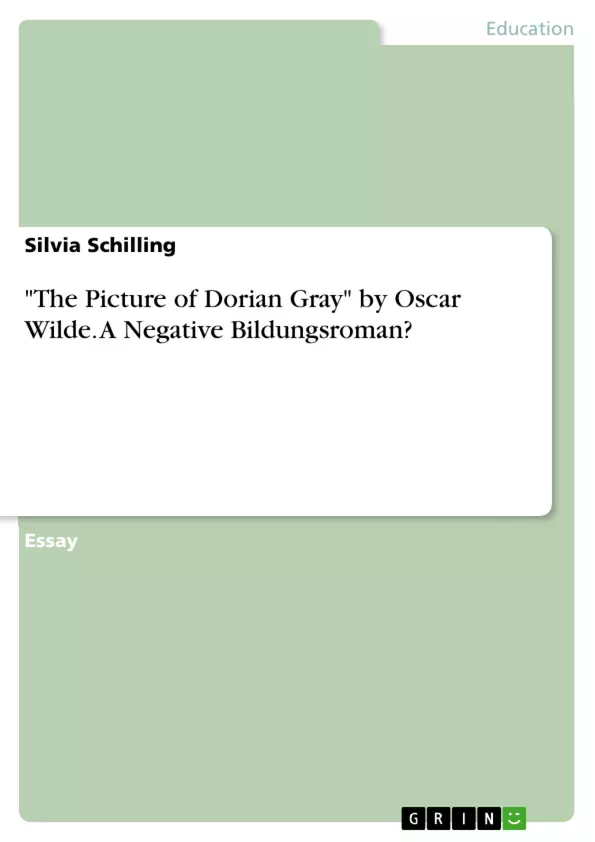This essay discusses Oscar Wilde's only novel "The Picture of Dorian Gray" as a bildungsroman. The essay gives a brief overview concerning the genre, defines the traditional bildungsroman and analyses how "The Picture of Dorian Gray" agrees with and differs from the traditional genre.
Inhaltsverzeichnis (Table of Contents)
- The Picture of Dorian Gray – A Negative Bildungsroman?
- The Introduction of Dorian Gray
- The Influence of Lord Henry Wotton
- The First Change of Dorian's Portrait
- The Meeting of Dorian Gray and Basil Hallward
- The Consequences of Immorality
- The Wish for Change
- The Destruction of the Portrait and Dorian Gray
Zielsetzung und Themenschwerpunkte (Objectives and Key Themes)
The main objective of this text is to analyze Oscar Wilde's The Picture of Dorian Gray and discuss whether it can be classified as a negative bildungsroman. The text explores the protagonist's moral decay and the impact of his choices on his character development.
- The concept of the bildungsroman and its variants
- Dorian Gray's moral development and deformation
- The role of external influences on Dorian's choices
- The significance of the enchanted portrait in Dorian's journey
- The consequences of immoral actions and the potential for redemption
Zusammenfassung der Kapitel (Chapter Summaries)
- The Picture of Dorian Gray – A Negative Bildungsroman?: This chapter introduces the concept of the bildungsroman and its variants, particularly the negative bildungsroman. It also establishes the context for analyzing The Picture of Dorian Gray as a potential example of this genre.
- The Introduction of Dorian Gray: This chapter examines the introduction of Dorian Gray in the novel, highlighting the unusual way he is presented as a passive object rather than an active agent. It also explores his initial character traits, his lack of personality, and his susceptibility to influence.
- The Influence of Lord Henry Wotton: This chapter analyzes the significant role of Lord Henry Wotton in Dorian's moral development. It discusses how Lord Henry's philosophies and views on life influence Dorian's choices and lead him down a path of pleasure and sin.
- The First Change of Dorian's Portrait: This chapter focuses on the first change in Dorian's portrait, triggered by the suicide of Sibyl Vane. It examines the impact of this event on Dorian's moral conscience and the potential for turning point in his journey.
- The Meeting of Dorian Gray and Basil Hallward: This chapter describes the reunion of Dorian Gray and Basil Hallward after years of estrangement. It highlights the confrontation between Dorian's true nature and his outward appearance, as well as Basil's attempt to save Dorian's soul.
- The Consequences of Immorality: This chapter explores the consequences of Dorian's immoral actions, including his murder of Basil Hallward. It examines the growing coldness and ruthlessness that result from years of sinning without consequences.
- The Wish for Change: This chapter examines Dorian's late-stage desire to change his life and make amends for his past. It explores the genuineness of his wish and the possibility of redemption.
- The Destruction of the Portrait and Dorian Gray: This chapter describes Dorian's final act of desperation, his attempt to destroy the portrait to erase all evidence of his sins. It concludes with his own destruction and the ultimate consequences of his choices.
Schlüsselwörter (Keywords)
The key concepts and themes explored in the text include: bildungsroman, negative bildungsroman, moral development, deformation, external influences, aestheticism, consequences of sin, redemption, and the power of art.
- Quote paper
- Silvia Schilling (Author), 2014, "The Picture of Dorian Gray" by Oscar Wilde. A Negative Bildungsroman?, Munich, GRIN Verlag, https://www.grin.com/document/320583



